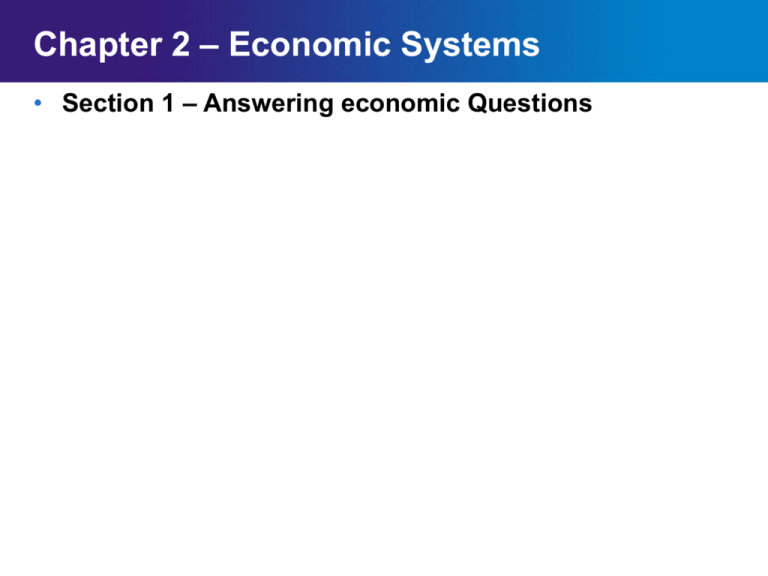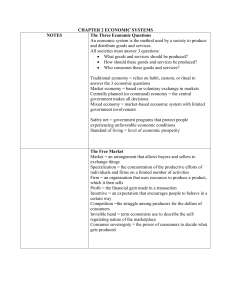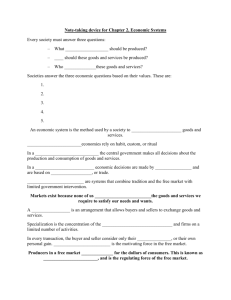Economics: Principles in Action
advertisement

Chapter 2 – Economic Systems • Section 1 – Answering economic Questions Chapter 2 Section Main Menu The Three Economic Questions • Every society must answer three questions: – What goods and services should be produced? – How should these goods and services be produced? – Who consumes these goods and services? • How a society answers these questions depends on how it values different economic goals. • As a result, four different economic systems have developed in response to these three questions. Chapter 2 Section Main Menu What goods and services should be produced? • Each society must decide what to produce in order to satisfy its needs and wants. • Often difficult to distinguish wants and needs Chapter 2 Section Main Menu Critical questions arise: • How much of our resources should we devote to national defense, education, public health and welfare, or consumer goods? • Which consumer goods should we produce? • Because of limited resources, each decision a society makes comes at an opportunity cost. Chapter 2 Section Main Menu How should these goods and services be produced? • How do we use our RESOURCES to produce goods and services? –Electricity with oil, solar or nuclear energy? –Classes with 20 or 30 students? –Corporate farms vs. family farms? • Countless ways to produce all things we want and need –All require land, labor, capital • Must determine these factors of production and the best way to use them to maximize efficiency on production possibilities curve Chapter 2 Section Main Menu Who consumes these goods and services? • Societies must decide how to distribute the available goods and services. • Who gets: –Luxury car vs. bus ticket? –Concert tickets vs stay home? –Well balanced diet vs hot dogs every meal? • Answer is determined how societies choose to distribute income. Chapter 2 Section Main Menu Factor Payments • The income people receive for supplying factors of production – land, labor, capital…or entrepreneurship • Simply put: how much money you make for the work you do. • Landowners – rent • Workers – wages • Lenders – interest • Entrepreneurs – profits (hopefully) • How much we pay the owners of the factors of production is determined by each society based on its own unique combination of social values and goals. Chapter 2 Section Main Menu Societies answer the three economic questions based on their values. Economic Goals Economic efficiency Economic freedom Making the most of resources – societies try to maximize what they can get for the resources they a have to work with Freedom from government intervention in the production and distribution of goods and services. The economic systems of different nations allow different degrees of economic freedoms. People all over the world face limitations on economic freedoms. predictability Assurance that goods and services will be available, payments will be made on time, and a safety net will protect individuals in times of economic disaster. Ex: milk & bread at the store; paychecks on time; SAFETY NET for natural disasters, job loss, injuries provided by govt to protect people; base income for retired & elderly so they can support themselves Economic equity Fair distribution of wealth. Most societies believe in equal pay for equal work but society does not value all jobs equally. All not able to work. Economic security and Economic growth and innovation Other goals Chapter 2 Section Innovation leads to economic growth, and economic growth leads to a higher standard of living. Economy must grow to provide new jobs and income for people. Innovation in technology increases efficiency of production & usher in new goods and services. Societies pursue additional goals, such as environmental protection, full employment, universal healthcare. Nations must prioritize inMain orderMenu of importance. Achieving any goal comes with some kind of trade-off. Four Economic Systems An economic system is the method used by a society to produce and distribute goods and services. •Traditional economies rely on habit, custom, or ritual to decide what to produce, how to produce it, and to whom to distribute it. •In a market economy economic decisions are made by individuals and are based on exchange, or trade. •In a centrally planned (command) economy the central government makes all decisions about the production and consumption of goods and services. •Mixed economies are systems that combine tradition and the free market with limited government intervention. Chapter 2 Section Main Menu TRADITIONAL • • • • • Little room for innovation/change Revolves around the family Work divided along gender lines – boys tend to follow father’s occupation; girls follow in mother’s footsteps Relatively small, close communities (think villages) Often work to support entire ethnic group rather than just themselves or immediate family 10 TRADITIONAL • • • Few mechanisms in place to deal with environmental disaster Tends to remain stagnant, resisting change at both individual and community level May not have access to goods and services • • • • • (ie no grocery stores or department stores) People make their clothes, tools, homes… Communities lack modern conveniences & low standard of living Found primarily in rural, non-industrial areas Examples: areas of Africa, South America, Asia, Middle East 11 Section 1 Assessment 1. Each society determines who will consume what is produced based on (a) its unique combination of social values and goals. (b) the amount of factor payments. (c) its needs and wants. (d) economic equity. 2. To improve its standard of living, a nation’s economy must (a) remain stable. (b) grow through innovation. (c) reach economic equity. (d) allow the central government to make economic decisions. Chapter 2 Section Main Menu Section 1 Assessment 1. Each society determines who will consume what is produced based on (a) its unique combination of social values and goals. (b) the amount of factor payments. (c) its needs and wants. (d) economic equity. 2. To improve its standard of living, a nation’s economy must (a) remain stable. (b) grow through innovation. (c) reach economic equity. (d) allow the central government to make economic decisions. Chapter 2 Section Main Menu Chapter 2 – Economic Systems • Section 2 – The Free Market Chapter 2 Section Main Menu The Free Market • How do free markets operate? • How can markets regulate themselves? • What are the advantages of a free market economy? Chapter 2 Section Main Menu Why Do Markets Exist? Markets exist because none of us produces all the goods and services we require to satisfy our needs and wants. A market is an arrangement that allows buyers and sellers to exchange goods and services. Chapter 2 Section Specialization is the concentration of the productive efforts of individuals and firms on a limited number of activities. Main Menu The Free Market Economy • In a free market economy, households and business firms use markets to exchange money and products. Households own the factors of production and consume goods and services. Circular Flow Diagram of a Market Economy Households pay firms for goods and services. Product market monetary flow physical flow Firms supply households with goods and services. Households Households supply firms with land, labor, and capital. Firms physical flow monetary flow Factor market Chapter 2 Section Main Menu Firms pay households for land, labor, and capital. The Market’s Self-Regulating Nature • In every transaction, the buyer and seller consider only their self-interest, or their own personal gain. Selfinterest is the motivating force in the free market. • Producers in a free market struggle for the dollars of consumers. This is known as competition, and is the regulating force of the free market. • The interaction of buyers and sellers, motivated by selfinterest and regulated by competition, all happens without a central plan. This phenomenon is called “the invisible hand of the marketplace.” Chapter 2 Section Main Menu Advantages of the Free Market Economic Efficiency Economic Freedom • As a self-regulating system, a free market economy is efficient. • Free market economies have the highest degree of economic freedom of any economic system. Economic Growth • Because competition encourages innovation, free markets encourage growth. Chapter 2 Section Additional Goals • Free markets offer a wider variety of goods and services than any other economic system. Main Menu Free Market Economy • Private ownership of property and resources • Profit • Competition • Consumer sovereignty • Individual choice 20 Free Market Economy • Private ownership of property and resources • Profit • Competition • Consumer sovereignty • Individual choice 21 Profit • consists of earnings after all expenses have been paid 22 competition • rivalry between producers/sellers of a good or service results in better quality goods and services at a lower price 23 Consumer sovereignty • Consumers determine prices through purchases, what goods and services will be produced 24 FREE MARKET 1. Individual consumers make decisions according to supply and demand 2. People are free to buy, sell, and produce whatever they want, whenever they want, and any way they want 25 FREE MARKET 3. People can work wherever they want 4. Capitalism is another name for market economies 5. People enjoy a free enterprise system 26 Section 2 Assessment 1. Why do people need to buy and sell goods or services? (a) People need to buy and sell goods to make a profit. (b) People buy and sell to maintain a competitive society. (c) No one is self-sufficient. (d) People need to provide the market with goods and services. 2. What factors create the phenomenon of the “invisible hand”? (a) incentives and efficiency (b) specialization and efficiency (c) competition between firms (d) competition and self-interest Chapter 2 Section Main Menu Section 2 Assessment 1. Why do people need to buy and sell goods or services? (a) People need to buy and sell goods to make a profit. (b) People buy and sell to maintain a competitive society. (c) No one is self-sufficient. (d) People need to provide the market with goods and services. 2. What factors create the phenomenon of the “invisible hand”? (a) incentives and efficiency (b) specialization and efficiency (c) competition between firms (d) competition and self-interest Chapter 2 Section Main Menu Chapter 2 – Economic Systems • Section 3 – Centrally Planned Economies Chapter 2 Section Main Menu Centrally Planned Economies • How are centrally planned economies organized? • How did the centrally planned economy of the former Soviet Union function? • What problems exist within centrally planned economies? Chapter 2 Section Main Menu Organization of Centrally Planned Economies In a centrally planned economy, the government owns both land and capital. The government decides what to produce, how much to produce, and how much to charge. Socialism is a social and political philosophy based on the belief that democratic means should be used to distribute wealth evenly throughout a society. Chapter 2 Section Communism is a political system characterized by a centrally planned economy with all economic and political power resting in the hands of the government. Main Menu The Former Soviet Union • Soviet Agriculture – In the Soviet Union, the government created large state-owned farms and collectives for most of the country’s agricultural production. • Soviet Industry – Soviet planners favored heavy-industry production (such as steel and machinery), over the production of consumer goods. • Soviet Consumers – Consumer goods in the Soviet Union were scarce and usually of poor quality. Chapter 2 Section Main Menu Problems of a Centrally Planned Economy Centrally planned economies face problems of poorquality goods, shortages, and diminishing production. Chapter 2 Section Main Menu Command Economy • Central ownership of property and resources • Centrally planned economy • Lack of consumer choice China Cuba 34 Command Economy 1. Government decides what products to make, how many to make, how to make them, and who gets them 2. Government controls factories, farms, natural resources, transportation systems, and stores 35 Command Economy 3. Individual has little or no say 4. Soviet Union used to have this type of economy 5. There is no competition 36 Section 3 Assessment 1. In a socialist country, (a) central planning is unnecessary. (b) the government often owns major industries, such as utilities. (c) an authoritarian government controls the economy. (d) economic equality is not important. 2. Which of the following is an advantage of a centrally planned economy? (a) the system’s bureaucracies are small and flexible (b) the system can work quickly to accomplish specific goals (c) innovation is well rewarded (d) consumers’ needs are well met Chapter 2 Section Main Menu Section 3 Assessment 1. In a socialist country, (a) central planning is unnecessary. (b) the government often owns major industries, such as utilities. (c) an authoritarian government controls the economy. (d) economic equality is not important. 2. Which of the following is an advantage of a centrally planned economy? (a) the system’s bureaucracies are small and flexible (b) the system can work quickly to accomplish specific goals (c) innovation is well rewarded (d) consumers’ needs are well met Chapter 2 Section Main Menu Chapter 2 – Economic Systems • Section 4 – Modern Economies Chapter 2 Section Main Menu Modern Economies • Why are many modern economies mixed economies? • What role does the government play in a mixed economy? • How do mixed economies in different countries compare? • What role does free enterprise play in the United States economy? Chapter 2 Section Main Menu The Rise of Mixed Economies Market economies, with all their advantages, have certain drawbacks. Limits of Laissez Faire Laissez faire is the doctrine that government generally should not interfere in the marketplace. Chapter 2 Section Governments create laws protecting property rights and enforcing contracts. They also encourage innovation through patent laws. Main Menu Government’s Role in a Mixed Economy In a mixed economy, Circular Flow Diagram of a Mixed Economy Product market • The government purchases land, labor, and capital from households in the factor market, and • Purchases goods and services in the product market. monetary flow physical flow Households expenditures Government physical flow monetary flow Factor market Chapter 2 Section Main Menu expenditures Firms Comparing Mixed Economies • An economic system that permits the conduct of business with minimal government intervention is called free enterprise. The degree of government involvement in the economy varies among nations. Continuum of Mixed Economies Centrally planned Free market Iran North Korea South Africa China Cuba Russia France Botswana Greece United Kingdom Canada Peru Source: 1999 Index of Economic Freedom, Bryan T. Johnson, Kim R. Holmes, and Melanie Kirkpatrick Chapter 2 Section Main Menu Hong Kong Singapore United States Mixed economy • Individuals and businesses as decision makers for the private sector • Government as decision maker for the public sector • Greater govt role than in free market economy • Most economic systems today Clip 44 MIXED 1. Individuals and government share the decision-making process 2. Businesses are usually privately owned 3. Most efficient way of providing consumers with goods and services 45 MIXED 4. Various agencies regulate businesses to ensure that they sell safe products, that they do not pollute the environment, and that they do not cheat consumers 46 Section 4 Assessment 1. The United States economy is a mixed economy (a) based on the principle of a traditional economy, but allows some government intervention. (b) based on the principles of a centrally planned economy, with limited government intervention. (c) based on the principles of the free market, and allows no government intervention. (d) based on the principles of the free market, but allows some government intervention. 2. Government intervention in a modern economy is useful because (a) the needs and wants of modern society are always met by the marketplace. (b) the marketplace has many incentives to create public goods such as parks and libraries. (c) governments are able to provide some goods and services that the marketplace has no incentive to produce. (d) the marketplace provides all of its own laws. Chapter 2 Section Main Menu Section 4 Assessment 1. The United States economy is a mixed economy (a) based on the principle of a traditional economy, but allows some government intervention. (b) based on the principles of a centrally planned economy, with limited government intervention. (c) based on the principles of the free market, and allows no government intervention. (d) based on the principles of the free market, but allows some government intervention. 2. Government intervention in a modern economy is useful because (a) the needs and wants of modern society are always met by the marketplace. (b) the marketplace has many incentives to create public goods such as parks and libraries. (c) governments are able to provide some goods and services that the marketplace has no incentive to produce. (d) the marketplace provides all of its own laws. Chapter 2 Section Main Menu




